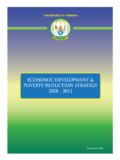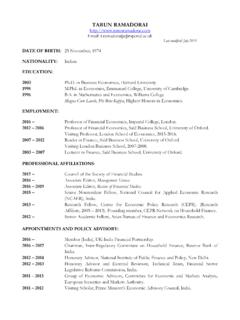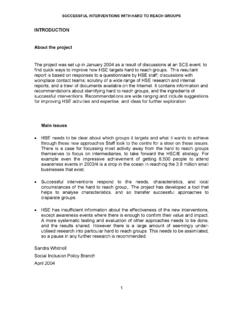Transcription of Impact of integrated marketing communications …
1 research in Business and Economics Journal 1 Impact of integrated marketing communications mix (IMCM) in small to medium enterprises (SMEs) in Zimbabwe as a marketing tool Catherine Mazwi R. Tsikirayi, University of Zimbabwe Blessing Muchenje University of Zimbabwe Zodeac Katsidzira University of Zimbabwe ABSTRACT The SME sector in Zimbabwe has assumed greater importance as the main employer of the displaced workforce, as well as being the main contributing sector to the economy of the country as supplier of essential goods and services. However, the many players in this sector do not seem to appreciate the critical role played by the marketing communications mix in getting their products and services to the market and making the potential customers aware of these products and services, the quality and benefits of the offerings.
2 While the subject of IMCM in general has been extensively covered, there has not been a direct study relating to SMEs in Zimbabwe. However, the study will focus mainly on the effectiveness of adopting IMCM in small enterprises not the minute details of the various elements of the IMCM. Keywords; Small to medium Enterprises (SMEs); integrated marketing communications Mix; Promotion; Advertising; Sales Promotions; Personal selling; Direct marketing ; Public relations. research in Business and Economics Journal 2 INTRODUCTION Small and medium enterprises play a major role in both the developing and developed world. They are regarded as the engine of economic growth globally (Amin and Banerjee, 2007). Madsing (1997) says that small and medium enterprises (SMEs) are responsible for 65% of employment and 57% of Gross Domestic Product (GDP) within the UK.
3 SMEs make a major contribution to private sector output and employment (Storey, 1994). They play tremendous roles in the provision of goods and services, employment generation and they enhance competition and entrepreneurship. They contribute to the Gross Domestic Products (GDPs) of many countries and create a better standard of living (Beck, Asli Demirgu -Kunt, and Vojislav Maksimovic, 2005). According to Kotler (2005), there have been very few studies conducted in relation to the relevance, significance and meaning of marketing communications in the context of small and medium sized enterprises (SMEs). This situation may have changed over the years but is still the case in the context of SMEs in Zimbabwe. The management of SMEs do not emphasize the promotion of goods and services.
4 There is no proper planning in promoting their products and services (Customer survey report, 2009). BACKGROUND SMEs in Zimbabwe have grown since the introduction of the Economic Structural Adjustment Program (ESAP) when Zimbabwe attained full sovereign status (Bhalla, Davies, Chitiga-Mabugu, and Mabugu, 1999). The introduction of the Economic Structural Adjustment Programme (ESAP) in 1991 resulted in loss of employment and the shrinking of the formal job market, impoverishment of people, thereby creating conditions for the proliferation of the SMEs. The land reform programme had a serious Impact on companies operating in the agricultural sector, and in particular, SMEs. The Indigenisation Bill (yr?) which promulgated the transfer of 51% shares from the big international companies to indigenous people created a wave of uncertainty and disinvestment, adding to the high levels of unemployment and the creation of more rickety SMEs.
5 The continued rural to urban migration spurred by a search for better opportunities in urban areas did not help either. This resulted in cities and towns becoming over-populated with people looking for employment in an economy with decreasing formal employment, resulting in them joining the SME sector. In addition, Zimbabwe s education system which expanded rapidly after independence produces thousands of job seekers every year, with little chance of finding work in an economy that saw 400 companies shut down (Kumbawa, 2002). The HIV/AIDS pandemic further fuelled the rush into the sector as many people, particularly women and children, suddenly acquired new roles of being bread winners after the family bread winners fall sick or die of AIDS. They are forced to find employment, mainly in the informal sector (an integral part of the SME sector) to earn a living (Bhalla et al.)
6 , 1999). Zimbabwe s economic downturn from the year 2000, resulting in companies closing down or downsizing their operations, was another scourge that put pressure on the SME sector. Foreign companies left the country and invested in South Africa and other countries in the region (Kumbawa, 2002). Many people in Zimbabwe lost their jobs and started their own businesses, resulting in a high proliferation of SMEs in different sectors of the economy. Bhalla et al. (1999) states that the growth of SMEs in Zimbabwe represented annual growth in turnover of 28 per cent between 1991 and 1995. SMEs contributed significantly to the economy, providing the goods and services that were in short supply from the year 2000 onwards, when large companies failed to produce enough to meet demand.
7 research in Business and Economics Journal 3 With the advent of a Government of National Unity (GNU) in February 2009, the political situation in the country became more stable and a little more conducive for business operations, especially SMEs. According to the African Economic Outlook (2011), the establishment of the Government of National. Today, SMEs in Zimbabwe are still the major producers of goods and services as most companies are still facing financial problems to boost their production. Against this background, analysts believe employment in the informal sector has far surpassed that in the formal economy, where only about 40% or million of the million working adults in Zimbabwe are still employed ( , accessed on 14-09-2010). Zimbabwe's unemployment rate has hiked to 94%, meaning that only a few people were formally employed and the rest were in the SME sector (CZI Business Intelligence Report, 2010).
8 Therefore, SMEs and micro-enterprises play a critical role in respect of both output and employment. EMPIRICAL STUDIES ON SMES AND THE marketing communications MIX Beaver (2002) observed that there is no universal definition of small business. The technical definition of SMEs varies from country to country and industry to industry, depending on the size of the economy. According to Beaver (2002), a small business can be defined qualitatively or quantitatively. Qualitative classification defines SMEs in terms of ownership whereas defining it quantitatively is done according to the number of employees, owner s equity, annual turnover or revenues and asset value (Beaver, 2002). This study adopts the which stipulates that small enterprises are independently owned, financed and operated and individually, they have relatively little Impact on their respective industries (Hodget and Kuratko, 1997 ).
9 In any economy the world over, SMEs contribute very significantly in terms of employment creation and economic growth. SMEs have provided practical solutions to challenges such as poverty and declining household incomes to meet family basics such as food, school fees, and access to health services, among others (Mukras, 2009). The development of the SMEs sector is therefore of paramount importance for any country irrespective of their level of development (Kiot, 2005). Among the various factors that facilitate the development and expansion of the SME sector is the ability of the entrepreneurs to ensure the market is educated about the existence of the product or service, its quality attributes, benefits and efficacy. To achieve this, the entrepreneur (manager) needs to engage an effective communications marketing mix ( integrated marketing communications mix).
10 Marcomm Wise (2006) defines marketing communications as all strategies, tactics, and activities involved in getting the desired marketing messages to intended target markets, regardless of the media use. Marketers have access to numerous forms of communication , referred to collectively as the marketing communications mix. Different authors have come up with varying elements of the communications mix. For example, Lovelock and Wirtz, (2004) says the communications mix includes advertising, personal selling, publicity, public relations, sales promotions, instructional materials, and corporate design. Customers need information about the features of the product, its price and how they can access it in order to make informed purchase decisions. This means that, having good effective communication channels adds value to the product of the company as customers have confidence in their purchase (Potluri, 2008).


















